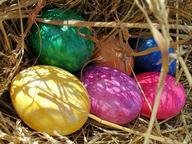Quiz Answer Key and Fun Facts
1. Eggs are a common symbol of Easter, due to being associated with fertility and birth. In Greece, what colour do Orthodox Christians dye eggs at Easter?
2. In which African country is it traditional to abstain from all meat or animal products for 55 days until Easter (known as Fasika)?
3. In Latvia, Easter is known as Lieldinas. As well as hard-boiled eggs, what other items - normally found in playgrounds - are associated with Lieldinas?
4. Lamb is a popular choice of dish for Easter in many countries, including Italy. Another Italian Easter food is a cake known as the Colomba di Pasqua. What is this cake shaped like?
5. In which Central American country would you see Easter parades taking place on colourful carpets known as 'alfombras'?
6. In Portugal, which nuts are traditionally covered in sugar and/or chocolate and exchanged as gifts at Easter?
7. Poland has an Easter tradition known as 'smigus-dyngus', which takes place on Easter Monday (or 'Dyngus Day' as Polish-Americans call it). According to tradition, what should men do to women on 'Dyngus Day'?
8. In Jamaica, bun - a rich, dark fruit cake - is eaten at Easter. What is Easter bun usually served with?
9. Rabbits are considered to be a pest and invasive species in Australia, so some Aussies came up with the idea of an alternative to the Easter Bunny. What chocolate animal did the Rabbit-Free Australia campaign propose instead?
10. In England, my home country, there are two types of cake associated with Easter. One of them is the hot cross bun, but what is the other one?
Source: Author
Kankurette
This quiz was reviewed by FunTrivia editor
stedman before going online.
Any errors found in FunTrivia content are routinely corrected through our feedback system.
